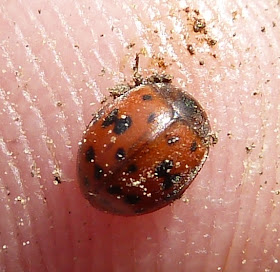Following on from
my introduction to 7-spot and harlequin ladybirds, in part 2 I want to look at some other common British species. The next most familiar is probably the 2-spot ladybird which has two common patterns which look like they could be separate species - either red with 2 black spots or (despite the common name) black with 4 or 6 red spots. The 2-spotted form has large white side-spots on the pronotum (a bit like 7-spots and harlequins and this can look like a black M/W mark) but the others have a more or less black pronotum. In all forms, the legs are black. The 2-spot is found on a wide range of plants in many habitats, and is common as a species that over-winters in buildings.
 |
| The two common colour forms of the 2-spot ladybird mating on a reedmace |
Another common species is the 24-spot which is a rusty orange-red colour with black spots. The exact number of spots varies (from 0 to 24, with 20 being a common number), and they can be fused - there are also darker forms but they are not as common as in the 2-spot. The elytra also have tiny hairs which are visible with a hand lens (and can just be seen in the photo below). This is found in grasslands where it eats leaves and is commonest in the south of Britain.
 |
| 24-spot ladybird found in loose soil on an ant-nest |
Keeping with the black-on-red species, the 11-spot is widespread and common on various plants on dunes and in other habitats. As is often the case with ladybirds, the number of spots varies (from 7 to 11, although 11 is most common) and the pronotum is black with white sides.
 |
| 11-spot ladybird escaping digging of soil |
Superficially similar to the 11-spot, Adonis' ladybird is less common with a more scattered and localised distribution, although it has been spreading recently. It is red with 3-15 black spots (often around 7) and the pronotum is black with variable, but generally more extensive, white edges and marks than the 11-spot (in the photo below you can see that the front edge of the pronotum is white).
 |
| Adonis' ladybird on plastic on a farm |
Lastly, the kidney-spot ladybird which is scattered but can be locally common, is black with 2 large orange or red spots. It is associated with various deciduous trees, especially willows, poplars, ash and birch, and is usually found at or near the base rather than higher up. The description may sound similar to the dark form of the 2-spot, but these have 4 or 6 red spots whereas kidney-spots have two red spots - this is why scientific names are so useful - common ones can be misleading. Also, the kidney-spot is much rounder when viewed from above and has splayed edges making it look almost tortoise-shaped. In the photo below you can see a yellow fungus growing on the rear of the elytra - if you want to know more about what this turned out to be,
have a look here - it was quite surprising.
 |
| Kidney-spot ladybird - note the yellow fungus growing at the rear |
So, that is 5 more ladybirds covered - don't forget that there are also the yellow-and-black species (they may form the subject of a separate post), plus some striped ones, some rareties and the micro-ladybirds. If this is a subject that interests you, there is a
UK Ladybird Survey for all abilities where you can send in records of your sightings which all helps understanding the dynamics and ecology of one of our most popular groups of insects.
Further reading
Majerus, M. & Kearns, P. (1989). Ladybirds. Richmond, Slough. An excellent little book with detailed keys to species, including the 'micros' - a new edition is being prepared.
Majerus, M., Roy, H., Brown, P. & Ware, R. (2006). Guide to Ladybirds of the British Isles. FSC, Preston Montford. A fold-out laminated sheet perfect for beginners.
Roy, H., Brown, P., Frost, R. & Poland, R. (2011). Ladybirds (Coccinellidae) of Britain and Ireland. FSC, Shrewsbury. Details of all species including maps, identification features, ecology and so on.
Common and scientific names of species mentioned here
7-spot: Coccinella septempunctata
Harlequin: Harmonia axyridis
2-spot: Adalia bipunctata
24-spot: Subcoccinella 24-punctata
11-spot: Coccinella 11-punctata
Adonis: Hippodamia variegata
Kidney-spot: Chilocorus renipustulatus





No comments:
Post a Comment